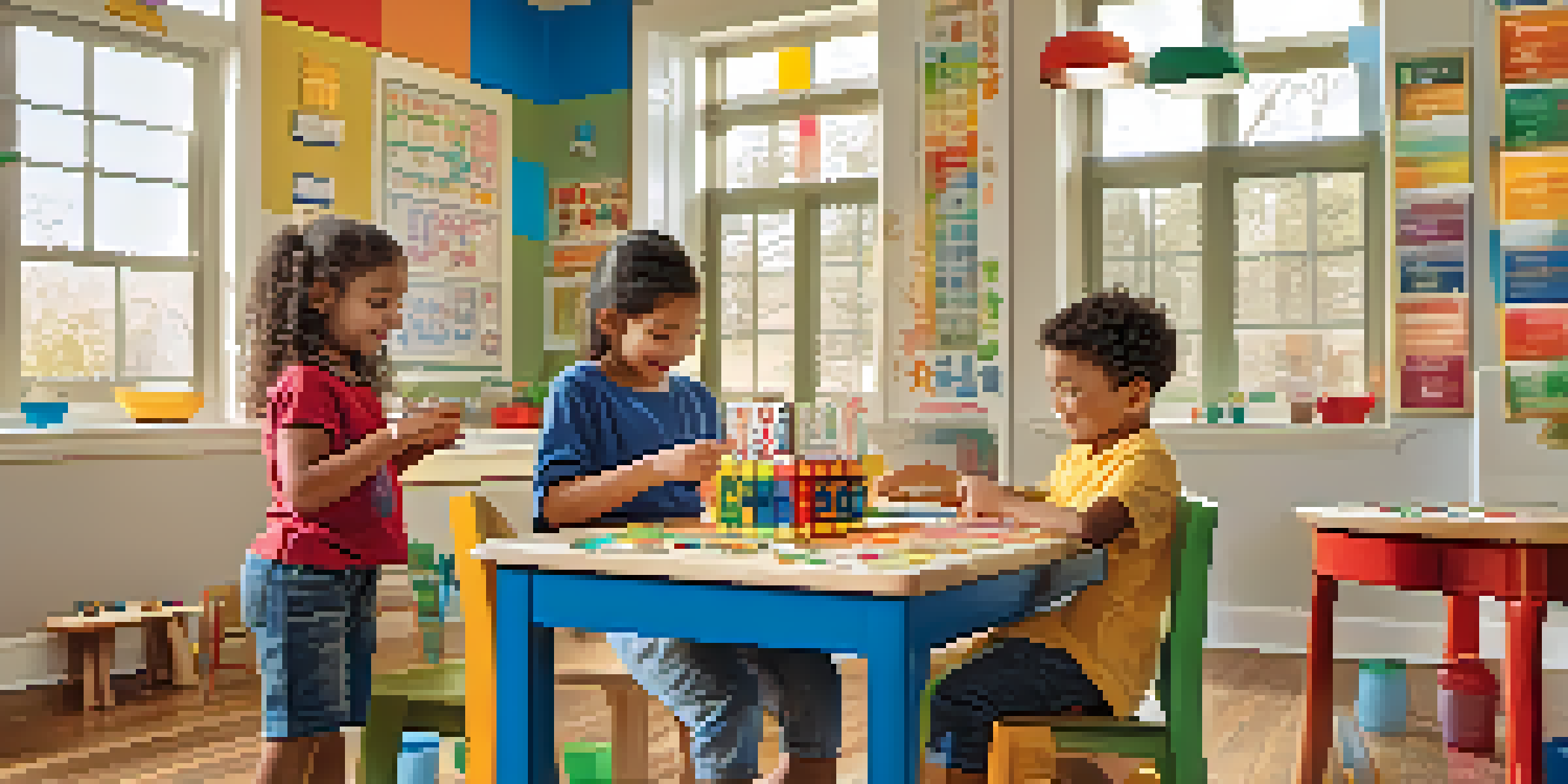Using Play to Teach Math Concepts to Young Learners

The Importance of Play in Early Childhood Learning
Play is a fundamental aspect of childhood, serving as a natural learning tool. Through play, children explore their world, enhance their creativity, and develop critical thinking skills. When it comes to math, play transforms abstract concepts into tangible experiences, making them easier for young learners to grasp.
Play is the highest form of research.
For instance, using building blocks can help children understand basic geometry and spatial awareness. As they stack and arrange blocks, they intuitively learn about shapes, balance, and even simple addition. This hands-on approach not only makes learning enjoyable but also reinforces essential math skills in a fun way.
Moreover, play fosters a positive attitude towards learning. When math is integrated into play, children are less likely to feel pressured or anxious, allowing them to approach challenges with curiosity and excitement. This confidence lays a strong foundation for future learning as they grow.
Incorporating Games into Math Lessons
Games are an excellent way to make math engaging for young learners. Simple board games or card games can introduce concepts like counting, addition, and subtraction without the pressure of formal instruction. For example, a game where players collect and count tokens can reinforce number recognition and basic arithmetic in a playful context.

Interactive games, whether digital or physical, can cater to various learning styles. Visual learners may thrive with games that involve colorful visuals and pieces, while auditory learners might benefit from games that incorporate songs or rhymes related to math. This variety ensures that all children can find joy in learning math.
Play Enhances Early Math Learning
Through play, children engage with math concepts in a hands-on manner, making learning enjoyable and effective.
Additionally, games encourage social interaction, which is vital for young learners. They teach teamwork, turn-taking, and communication skills while naturally reinforcing math concepts. As children engage with peers, they discuss strategies, share ideas, and collaboratively solve problems, all of which enhance their understanding of math.
Hands-On Activities to Teach Math Concepts
Hands-on activities are effective for teaching math because they allow children to manipulate objects and see the results of their actions. For instance, using measuring cups in a pretend kitchen can introduce concepts of volume and measurement in a tangible way. Children learn to compare sizes, understand fractions, and even practice basic addition and subtraction through cooking.
Tell me and I forget. Teach me and I remember. Involve me and I learn.
Sensory bins filled with items like beans or rice can also be used to create engaging math activities. Children can sort, count, and group items, which promotes fine motor skills while reinforcing math concepts. This tactile interaction makes learning memorable, as children connect the physical objects to the numbers they represent.
Through these activities, children not only learn math but also develop problem-solving skills. They encounter challenges, experiment, and find solutions, which fosters a deeper understanding of mathematical concepts. This experiential learning approach cultivates a sense of accomplishment and encourages a lifelong love for math.
Storytelling as a Math Teaching Tool
Storytelling is a powerful technique to introduce math concepts in a relatable way. By weaving math into stories, educators can create a narrative that captures children's imaginations while teaching them important skills. For example, a story about animals sharing apples can help illustrate division or fractions in a fun, engaging context.
As children hear stories that incorporate numbers and problem-solving, they begin to see math as a part of everyday life. It helps them understand the relevance of math beyond the classroom. When they relate to characters and their challenges, they become more invested in finding solutions, which enhances their comprehension.
Games Foster Math Engagement
Incorporating games into math lessons provides a fun way to teach essential skills while encouraging social interaction.
Additionally, storytelling encourages active participation. Children can act out stories or create their own, allowing them to explore math concepts creatively. This interactive approach not only reinforces learning but also nurtures communication skills, as children articulate their thoughts and ideas while engaging with math.
Exploring Nature to Teach Mathematical Concepts
Nature provides a rich backdrop for teaching math concepts through exploration. Outdoor activities, like counting leaves or measuring the height of a tree, can help children connect math to the world around them. This hands-on experience with nature enhances their observational skills and allows them to apply math in real-life situations.
For instance, a nature scavenger hunt can incorporate counting and sorting as children search for specific items like rocks or flowers. By collaborating with peers, they can also practice addition as they tally their finds. This playful outdoor learning fosters a sense of curiosity and encourages children to engage with math in a meaningful way.
Moreover, nature inspires creativity and critical thinking. As children observe patterns, shapes, and sizes in the natural world, they start to understand geometry and measurement intuitively. This connection to nature not only enriches their math skills but also promotes a sense of wonder and appreciation for the environment.
Using Technology to Enhance Math Learning
In today's digital age, technology can be a valuable ally in teaching math concepts to young learners. Educational apps and games designed for early math skills provide interactive experiences that captivate children's attention. These digital tools often include colorful graphics and engaging storytelling, making math practice enjoyable.
For example, apps that involve puzzles or problem-solving challenges can reinforce concepts like shapes, counting, and basic addition. Children can learn at their own pace, receiving immediate feedback that helps them understand their progress. This self-directed learning fosters independence and confidence in their math abilities.
Nature Connects Math to Real Life
Exploring nature allows children to apply math concepts practically, enhancing their observational skills and creativity.
However, it's essential to balance screen time with hands-on activities. While technology can enhance learning, incorporating traditional play and exploration is equally important. A blended approach allows children to experience math through various mediums, ensuring they develop a well-rounded understanding of mathematical concepts.
Creating a Math-Friendly Environment at Home
Creating a math-friendly environment at home encourages children to engage with math in their everyday lives. Parents can incorporate math into daily routines, such as counting items during grocery shopping or measuring ingredients while cooking together. These simple activities help children see math as a natural part of life, rather than a separate subject.
In addition, providing access to math-related games, books, and puzzles can stimulate interest and curiosity. By surrounding children with math-focused materials, parents can spark conversations and learning opportunities. For example, reading books that incorporate counting or shapes can reinforce math concepts in a fun and interactive way.

Lastly, fostering a positive attitude towards math is crucial. Parents should celebrate their child's successes, no matter how small, and encourage a growth mindset. When children feel supported and motivated, they are more likely to embrace challenges and develop a love for learning math.